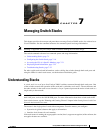
6-13
Catalyst 2960 and 2960-S Switch Software Configuration Guide
OL-8603-09
Chapter 6 Clustering Switches
Planning a Switch Cluster
When the previously active cluster command switch resumes its active role, it receives a copy of the
latest cluster configuration from the active cluster command switch, including members that were added
while it was down. The active cluster command switch sends a copy of the cluster configuration to the
cluster standby group.
IP Addresses
You must assign IP information to a cluster command switch. You can assign more than one IP address
to the cluster command switch, and you can access the cluster through any of the command-switch IP
addresses. If you configure a cluster standby group, you must use the standby-group virtual IP address
to manage the cluster from the active cluster command switch. Using the virtual IP address ensures that
you retain connectivity to the cluster if the active cluster command switch fails and that a standby cluster
command switch becomes the active cluster command switch.
If the active cluster command switch fails and the standby cluster command switch takes over, you must
either use the standby-group virtual IP address or any of the IP addresses available on the new active
cluster command switch to access the cluster.
You can assign an IP address to a cluster-capable switch, but it is not necessary. A cluster member switch
is managed and communicates with other cluster member switches through the command-switch IP
address. If the cluster member switch leaves the cluster and it does not have its own IP address, you must
assign an IP address to manage it as a standalone switch.
For more information about IP addresses, see Chapter 3, “Assigning the Switch IP Address and Default
Gateway.”
Hostnames
You do not need to assign a host name to either a cluster command switch or an eligible cluster member.
However, a hostname assigned to the cluster command switch can help to identify the switch cluster. The
default hostname for the switch is Switch.
If a switch joins a cluster and it does not have a hostname, the cluster command switch appends a unique
member number to its own hostname and assigns it sequentially as each switch joins the cluster. The
number means the order in which the switch was added to the cluster. For example, a cluster command
switch named eng-cluster could name the fifth cluster member eng-cluster-5.
If a switch has a hostname, it retains that name when it joins a cluster and when it leaves the cluster.
If a switch received its hostname from the cluster command switch, was removed from a cluster, was
then added to a new cluster, and kept the same member number (such as 5), the switch overwrites the
old hostname (such as eng-cluster-5) with the hostname of the cluster command switch in the new cluster
(such as mkg-cluster-5). If the switch member number changes in the new cluster (such as 3), the switch
retains the previous name (eng-cluster-5).
Passwords
You do not need to assign passwords to an individual switch if it will be a cluster member. When a switch
joins a cluster, it inherits the command-switch password and retains it when it leaves the cluster. If no
command-switch password is configured, the cluster member switch inherits a null password. Cluster
member switches only inherit the command-switch password.


















